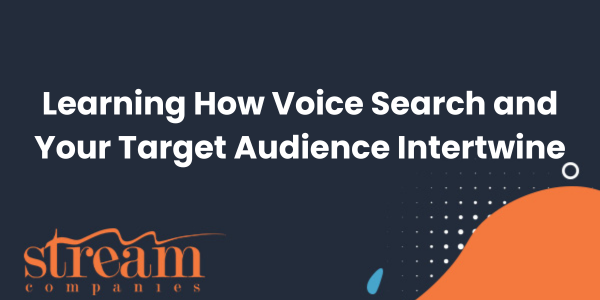We invite you to imagine a radical future. In this wild vision, all people are all but connected at the hip to a portable supercomputer at all times. And all they have to do is speak the word and these machines will do their bidding, providing them with any and all pieces of information that have ever been known throughout the entire history of humankind. Oh, wait… That future is already here, and you’re living in it.
We’re almost certain that you’ve already incorporated voice search into your personal life; perhaps you even discovered this article via a voice search. But we’re less certain that you’ve effectively incorporated the reality of its prominence into your business’s marketing strategy, especially when it comes to SEO.
And what does it mean to effectively incorporate this technology? Here’s a hint: It’s about your audience.
For more than a hint, check out this helpful guide from the Stream Companies team on the many ways in which voice search and your target audiences intertwine. Make sure to drop us a line with any questions!
Voice Search as a Revolutionary Technology: Position 0
When voice search first hit the scene in full force, many SEO specialists and pundits declared it a second-coming. This was supposed to be the technology that was going to revolutionize the SEO game for the next decade or two, and anybody who wasn’t along for the ride was going to get left in the dust. The main rationale behind this thinking was that voice search makes traditional SEO strategies obsolete because it only returns a single result to the searcher. This result (which was brilliantly named ‘position 0’) becomes the coveted prize.
But times change quickly in the world of SEO, and some of those same experts are now saying that such a take on voice search is sooo 2018. Instead, they’re advocating for a more measured approach to voice search optimization: Instead of putting all your energy into it, you must consider your target audience.
The Golden Rule: Consider Your Audience
That’s right—it turns out that voice search is just like any other tool in a marketer’s toolkit. Surprise, surprise… Its importance depends on which audience you’re trying to reach and how they engage with it.
When considering your voice search strategy, some of the most important factors to look into are your audience’s technological savvy, their age range, and the platform that they generally use to voice search.
All the hard data that we’ve cited below is from a 600+ person survey conducted by Path Interactive. For a more detailed glimpse into these numbers, read Lily Ray’s brilliant article on Search Engine Land.
Tech Skill Level
Obviously, the more tech savvy your target audience, the more they’ll take advantage of the various voice-search technologies that are out there. Even the data from the Path Interactive survey is skewed to represent the habits and preferences of particularly tech-savvy users: In terms of their tech-savviness, 30% of them labeled themselves a five out of five, 47% a four out of five, and 19% a three out of five.
If your business tends to target audiences that may as well be stuck in the Stone Age, you shouldn’t overemphasize voice-search optimization in your marketing plan. Instead, focus on lower-tech solutions.
Age
As far as age goes, there were some surprising survey results: Users 65 years old and up were actually the heaviest voice searchers! 25% of them searched more than three times per day and 50% of them searched one to three times per day. In second place came the 13-18 age range, with 40% of them searching over three times per day and 20% of them searching one to three times per day. If the product, service, or information that your organization focuses on is intended for consumers in these age ranges, then voice SEO should be a priority.
Platform
To make things more interesting (or more fun, if you’re the type of marketer who likes a challenge), different age ranges tend to gravitate towards different voice-search platforms, and this means that you should deploy a nuanced SEO strategy that takes into account these general trends. Take a look right here.
- Google Home: Google Assistant is by far the most popular technology for conducting a voice search. With a healthy plurality of 37% of all users on Google Home alone, as well as 41% of users ages 45-54, Google, as usual, emerges as the kingpin of a new type of search. No surprise.
- Android: Then there’s the mobile Android voice search capability, which adds another 16% of all users to Google Assistant’s domain. Once again, Google is the kingpin, and you should always curry favor with the kingpin. Regardless of your target audience, you should take Google’s voice-search algorithms into consideration when you create your content. However, this shouldn’t feel like too much of a departure from business as usual, as most marketers and SEO specialists are already accustomed to focusing on Google during every moment of the day.
- Siri: Sticking with the whole mobile-voice-search theme, Apple’s Siri is also just short of ubiquitous, with around 25% of all users conducting their voice searches on their iPhone® or other compatible Apple devices. Furthermore, it’s popular with people ages 13 to 18 and 55 to 64. This is an interesting combination of demographics, as it’s not too difficult to imagine that 13 to 18 year-old teenagers could be the driving forces behind some of the purchasing decisions of their 55 to 64 year-old parents. If you think that this might be the case for your industry, make sure that your business is listed on Apple Maps, and that any apps you develop are optimized for the app store on the iPhone®.
- Amazon Alexa: The last of the major players, Amazon Alexa accounts for about 18% of voice searches (many of which are conducted through an Amazon Echo smart speaker). However, the truly eye-popping number is that 57% of all 65+ year olds perform their voice searches here. We didn’t know that until we wrote this article, but the comedic geniuses over at Saturday Night Live clearly did. When it comes to this platform, the name of the game is Amazon SEO—a set of strategies and best practices that increase the likelihood of your product ending up in the top spot on Amazon. This is a bigger deal than you might think, as Robin Hanna explains: “More than 66% of shoppers now start their search for new products [directly] on Amazon.” Are you ready?
- Cortana: With only 4% of the market under its command, most of the voice searches conducted on Microsoft’s Cortana platform are just Bill Gates looking up his celebritynetworth.com profile.
Other Tips and Tricks for Voice SEO
There are a couple of other good habits that you should get into as you start your voice SEO journey, but these don’t necessarily depend on your target audience in the same ways as the ones above, but we thought that they’d be important to mention nevertheless. Don’t hesitate to ask us any questions that come up…
- Include structured data so that search engines readily tag your content for voice.
- Optimize your content to show up in Google’s Featured Snippets box.
- Enlist content wizards to ensure that everything is well-formatted.
- Work with your web development team to boost your page speed.
We also encourage you to read up on how the right (or wrong) SEO team can make (or break) your site…
Here at Stream, we’re on the cutting edge of voice-search optimization!
So why not hire the team that’s setting the standard for an entire industry? We’ll craft a voice-search strategy that’s perfectly tailored to your business’s target audience. If you’d like to learn a bit more about what we do before you contact us, check out our eBook: How Stream Does Search Engine Optimization!

